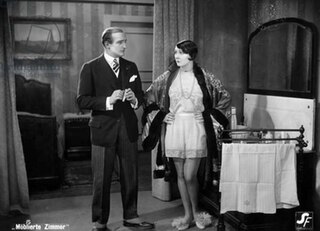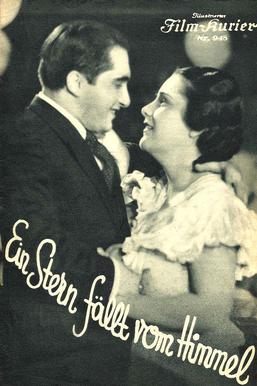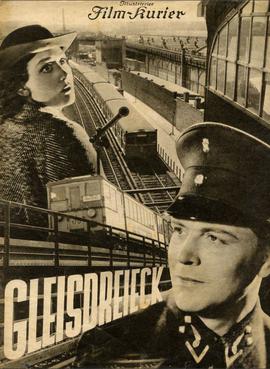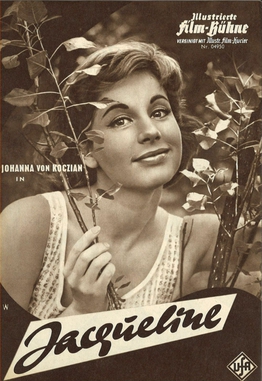
The Marriage of Mr. Mississippi is a 1961 Swiss-West German comedy film directed and co-written by Kurt Hoffmann and starring O.E. Hasse, Johanna von Koczian and Martin Held. It is based on the 1952 play of the same name by Friedrich Dürrenmatt. It was entered into the 11th Berlin International Film Festival. The film was shot at the Spandau Studios in Berlin, and on location in Zurich. The sets were designed by the art directors Hertha Hareiter and Otto Pischinger.

The Legacy of Pretoria is a 1934 German drama film directed by Johannes Meyer and starring Paul Hartmann, Charlotte Susa and Paul Henckels. It was based on the novel Die Reise nach Pretoria by Ludwig von Wohl. A German man inherits a business in South Africa, but struggles to run it.

Old Heidelberg is a 1959 West German drama film directed by Ernst Marischka and starring Christian Wolff, Gert Fröbe and Sabine Sinjen. It is an adaptation of the 1901 play Old Heidelberg by Wilhelm Meyer-Förster.

The Gasman is a 1941 German comedy film directed by Carl Froelich and starring Heinz Rühmann, Anny Ondra and Walter Steinbeck. It was shot at the Tempelhof Studios in Berlin and premiered in the city's Gloria-Palast. The film's sets were designed by Walter Haag. It was made by Froelich's separate production unit, and distributed by the major studio UFA.
That Was Heidelberg on Summer Nights is a 1927 German romance film directed by Emmerich Hanus and starring Fritz Alberti, Charlotte Susa and Olga Engl. The film was shot on location in Heidelberg.

Paul and Pauline is a 1936 German comedy film directed by Heinz Paul and starring Ludwig Manfred Lommel, Trude Hesterberg and Erika Helmke. It was shot at the Terra Studios in Marienfelde in Berlin.

Furnished Room is a 1929 German silent drama film directed by Fred Sauer and starring Margot Landa, Fritz Schulz and Hans Albers. It was shot at the Johannisthal Studios in Berlin. The film's sets were designed by art director Max Heilbronner.

The Copper, or The Grasper, is a 1930 British-German crime film directed by Richard Eichberg and starring Hans Albers, Charlotte Susa, and Margot Landa. It is the German-language version of the British film Night Birds, which was also directed by Eichberg but with an English-speaking cast. Both films were made by British International Pictures at their Elstree Studios at a time when such multiple-language versions were common.

A Star Fell from Heaven is a 1934 Austrian musical film directed by Max Neufeld and starring Joseph Schmidt, Egon von Jordan and Herbert Hübner. It was shot at the Sievering Studios in Vienna. Two years later it was remade in Britain with Schmidt reprising his role. A later German-language film A Star Fell from Heaven released in 1961, was unconnected to the earlier productions.

Regine is a 1935 German drama film directed by Erich Waschneck and starring Luise Ullrich, Anton Walbrook and Olga Chekhova. It was shot at the Grunewald Studios in Berlin. The film's sets were designed by Otto Erdmann and Hans Sohnle.
Revolt in the Batchelor's House is a 1929 German silent comedy film directed by Manfred Noa and starring Sig Arno, Kurt Gerron and Trude Hesterberg.

Three Days of Fear is a 1952 West German comedy crime film directed by Erich Waschneck and starring Rudolf Platte, Camilla Spira and Cornelia Froboess. It was shot at the Göttingen Studios. The film's sets were designed by Hans Jürgen Kiebach and Gabriel Pellon.

Men Are That Way is a 1939 German drama film directed by Arthur Maria Rabenalt and starring Hertha Feiler, Hans Söhnker and Hans Olden. The film's sets were designed by the art director Willi Herrmann. It was remade by Rabenalt in Austria as Arena of Fear (1959).

She and the Three is a 1935 German comedy crime film directed by Victor Janson and starring Gustav Waldau, Charlotte Susa and Hubert von Meyerinck.

Dangerous Crossing or Rail Triangle is a 1937 German crime film directed by Robert A. Stemmle and starring Gustav Fröhlich, Heli Finkenzeller, and Paul Hoffmann. It is set amongst railway workers and takes its name from Gleisdreieck on the Berlin U-Bahn. It was partly shot at the Babelsberg Studios in Potsdam. The film's sets were designed by the art directors Carl Böhm and Erich Czerwonski. It was shot on location around Berlin. It premiered at the city's Ufa-Palast am Zoo.

The Daredevil is a 1931 German crime film directed by Richard Eichberg and starring Hans Albers, Gerda Maurus and Mártha Eggerth.

Two Under the Stars is a 1927 German silent film directed by Johannes Guter and Ernst Wolff and starring Margarete Schlegel, Ernst Deutsch and Jean Angelo.

The Glass Ball is a 1937 German drama film directed by Peter Stanchina and starring Albrecht Schoenhals, Sabine Peters, and Hilde von Stolz.

Jacqueline is a 1959 West German comedy film directed by Wolfgang Liebeneiner and starring Johanna von Koczian, Walther Reyer and Götz George. George won a German Film Award for best newcomer for his performance.

Helene Willfüer, Student of Chemistry is a 1930 German silent drama film directed by Fred Sauer and starring Olga Chekhova, Ernst Stahl-Nachbaur and Elza Temary. It is based on the 1928 novel of the same title by Vicki Baum, which was subsequently remade as the 1936 French film Hélène and the 1956 West German film Studentin Helene Willfüer. The film's sets were designed by the art director Max Heilbronner. Location shooting took place around Heidelberg.


















